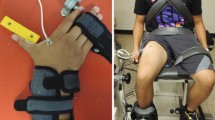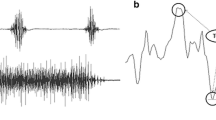Summary
Surface electromyography (EMG) in the past has been used to estimate the intensity of muscle contraction. These estimates were derived from the EMG/force relationship measured at room temperature. How the surface EMG signal is influenced by varying air temperature as it relates to the EMG/force relationship has yet to be investigated. Thus, this study evaluated the influence of different air temperatures (10, 23 and 40° C) on surface EMG during contractions of the quadriceps muscle. Ten subjects [mean (SD) age 29 (7) years and weight 78.3 (7.8) kg] performed a criterion task of five contractions ranging from 10 to 100% of a maximal voluntary contraction, five times over a 1.5-h period in all conditions. The EMG signals generated from the rectus femoris, and the forces associated with the contractions, were captured on FM tape and subsequently digitized at a sampling rate of 2000 Hz. The relationship between EMG and force was different under the different conditions; EMG was reduced at a given force as temperature increased, and the EMG increased in the 10° C environment over time. The differences that occurred at the various temperatures were believed to be related to fluid distribution in the muscle, muscle conduction velocity and sweating. The data imply that the EMG/force relationship measured using surface electrodes is influenced by ambient temperature.
Similar content being viewed by others
References
Bell DG, Tikuisis P, Jacobs I (1992) Relative intensity of muscular contraction during shivering. J Appl Physiol 72:2336–2342
Bigland-Ritchie B (1981) EMG/force relations and fatigue of human voluntary contraction. In: Miller DI (ed) Exercise and sport sciences reviews (vol 9). Franklin Institute, Chicago, Ill., pp 75–117
Clarys JP, Robeaux R, Delbeke G (1984) Telemetrical versus conventional EMG in air and water. In: Winter D, Norman R (eds) Biomechanics IX. Human Kinetics, Campaign, Ill., pp 286–294
De Luca CJ (1979) Physiology and mathematics of myoelectric signals. IEEE Trans Biomed Eng 26:313–325
De Luca CJ (1985) Myoelectric manifestation of localized muscular fatigue in humans. CRC Crit Rev Biomed Eng 11:251–279
Dixon JW (1983) BMDP Statistical Software. University of California Press, Berkeley, Calif.
Komi PA, Viitasalo JHT (1976) Signal characteristics of EMG at different levels of muscle tension. Acta Physiol Scand 96:267–276
Kuroda E, Kilssouras V, Milsum JH (1970) Electrical and metabolic activities and fatigue in human isometric contraction. J Appl Physiol 29:358–367
Martineau L, Jacobs I (1988) Muscle glycogen utilization during shivering thermogenesis in humans. J Appl Physiol 65:2046–2050
Moritani MA, DeVries HA (1978) Reexamination of the relationship between the surface integrated electromyogram (IEMG) and force of isometric contraction. Am J Phys Med 57:263–277
Petrofsky JS, Lind AR (1980) The influence of temperature on the amplitude and frequency components of the EMG during brief and sustained isometric contractions. Eur J Appl Physiol 44:189–200
Ricker K, Hertel G, Stodieck G (1977) Increased voltage of the muscle action potential of normal subjects after local cooling. J Neurol 216:33–38
Tikuisis P, Bell DG, Jacobs I (1992) Shivering onset, metabolic response, and convective heat transfer during cold air exposure. J Appl Physiol 70:1996–2002
Winkel J, Jorgenson K (1991) Significance of skin temperature changes in surface electromyography. Eur J Appl Physiol 63:345–348
Woods JJ, Bigland-Ritchie B (1983) Linear and non-linear surface EMG/force relationships in human muscles. Am J Phys Med 62:287–299
Author information
Authors and Affiliations
Rights and permissions
About this article
Cite this article
Bell, D.G. The influence of air temperature on the EMG/force relationship of the quadriceps. Europ. J. Appl. Physiol. 67, 256–260 (1993). https://doi.org/10.1007/BF00864225
Accepted:
Issue Date:
DOI: https://doi.org/10.1007/BF00864225




